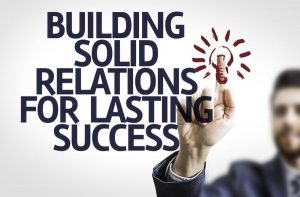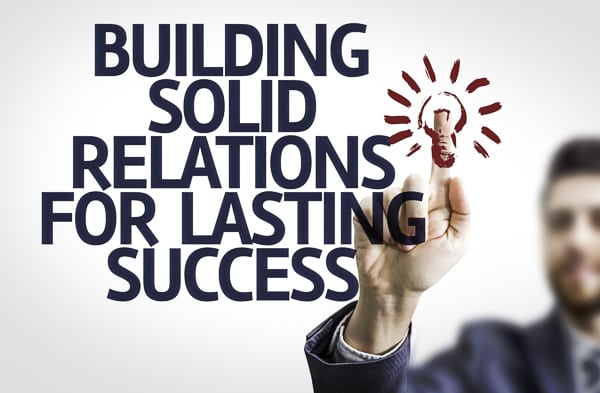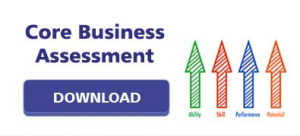We’re a quarter of the way into the new year and a word is emerging among my seemingly unconnected clients. It’s progress. Whether it’s slow, deliberate, micro — it doesn’t matter. Progress in all shapes, sizes, and speeds is being celebrated as the powerful business strategy it is.
 Gone is the mad dash to perfectionism. No more is the frantic pace of getting everything done now. The stress-inducing race to the finish line called perfection is being discarded — left behind — for a more realistic and thoughtful perspective on business growth.
Gone is the mad dash to perfectionism. No more is the frantic pace of getting everything done now. The stress-inducing race to the finish line called perfection is being discarded — left behind — for a more realistic and thoughtful perspective on business growth.
Progress is being celebrated in spirited conversations. It’s not a resignation, as in “well, at least I’m making progress.” It’s a jubilance that comes with recognizing that one deliberate step at a time is worthy of joy. And, along with these joy-filled moments of acknowledgment comes a deep satisfaction and confidence that we’re on our way.
The Curse Of Perfectionism
The mad dash of earlier years as we rushed into the acceleration of business growth is, as we’ve discovered and come to admit, unrewarding. It is stress-filled and fatiguing. And, what’s more, the zoom that filled each day actually takes us further away from that we desired.
Surprisingly, perfectionism doesn’t contribute to the degree of growth we thought would be achieved. We willingly, knowingly, and consciously chose the path, with its windy, steep, uphill climbs. And, we tackled it at a fevered pitch. Battered and bruised, we marched into each day to do battle once more with our business environment only to discover little progress being made in exchange for the mammoth amount of effort and energy we expelled during our quest for perfection.
Baby Steps & Business Growth
So, it appears, this year is a more thoughtful and deliberate year as we approach our business growth with greater awareness and celebration.
Along with the celebration of progress, we’re learning that the joyful expression of a proverbial pat on the back can carry us quite a distance. It’s uplifting and encouraging. It builds our confidence and competence. It opens our eyes to possibilities and opportunities previously unseen. And, it carries us victoriously from hour to hour and day to day.
Progress, and the subsequent celebration of it, is a good path to travel.
Whether it’s overcoming the reluctance and fear to make the sales call or pulling the trigger and publishing the blog you thought was not quite “perfect,” each step — each action — each micro-movement is worthy of celebration.
Gone are the days in which we need to wait to celebrate and declare success until Facebook/Amazon/Google behemoth-size success is achieved. If we are honest, that is unlikely going to happen. Not only is it unlikely to happen, it is not our goal or dream to begin with. Thinking about it makes it laughable.
So, progress. Every day in every way you get better and better. Every day in every way you get closer to your desired vision. Every day in every way you move along the continuim of your success.
And, with a focus on progress rather than perfection, the road you travel — although it still contains its twists and turns and uphill climb — becomes a much sweeter journey. It’s one filled with greater joy and laughter. Where frequent breaks allow you to enjoy the smell of the fresh air, the pungent aroma of the pine trees, and experience the people you meet along the way.
Progress — it’s a joyful journey with the same destination as that of perfection.
Progress, measured and counted out like a metronome, takes us one step at a time, one action at a time, one motion at a time to our destiny.
There’s nothing more to say about it — other than to encourage YOU to consider which path you’re embracing. Is it that of perfection with its rushing, hurried, breathless pace? Or is it progress with its joy-filled, measured steps and outcomes?
Choose Progress over Perfection
 I don’t know about you but I, for one, will be joining my colleagues in choosing progress. I, too, will celebrate each step along the way rather than wait until the end to be too tired, too exhausted, too fatigued to care to celebrate what the quest for perfection produced.
I don’t know about you but I, for one, will be joining my colleagues in choosing progress. I, too, will celebrate each step along the way rather than wait until the end to be too tired, too exhausted, too fatigued to care to celebrate what the quest for perfection produced.
I will honor the progress made during each day knowing that step by step, inch by inch, day by day, progress (not perfection) is truly the key to my heart’s desire.
There’s nothing more to say about it, but to get to it. The day is awaiting for progress to be made.






 According to
According to  A business strategy provides a window into the future. It allows you to consider different paths your business might take. And, as your business continues to grow, It opens up opportunities to explore the development of other products and services.
A business strategy provides a window into the future. It allows you to consider different paths your business might take. And, as your business continues to grow, It opens up opportunities to explore the development of other products and services.
 Doing brand research.
Doing brand research. Developing your branding.
Developing your branding. If you did the necessary research prior to starting your brand development, your branding should be generating sales and producing customer loyalty. However, if you are like many entrepreneurs starting, you may have overlooked a step or two. Don’t worry, it’s never too late to rebrand.
If you did the necessary research prior to starting your brand development, your branding should be generating sales and producing customer loyalty. However, if you are like many entrepreneurs starting, you may have overlooked a step or two. Don’t worry, it’s never too late to rebrand.
 It’s a rather insidious process. Much like dust seeping through closed windows. You don’t realize it happening until one day — BAM! You can write your to-do list in the lingering grit.
It’s a rather insidious process. Much like dust seeping through closed windows. You don’t realize it happening until one day — BAM! You can write your to-do list in the lingering grit. So as not to overwhelm you with activities designed to move us to underwhelm, here are a few things for you to consider. Collectively, they will reduce the amount of complexity and overwhelm in your day and open up some white space for you to think more creatively and clearly.
So as not to overwhelm you with activities designed to move us to underwhelm, here are a few things for you to consider. Collectively, they will reduce the amount of complexity and overwhelm in your day and open up some white space for you to think more creatively and clearly.
